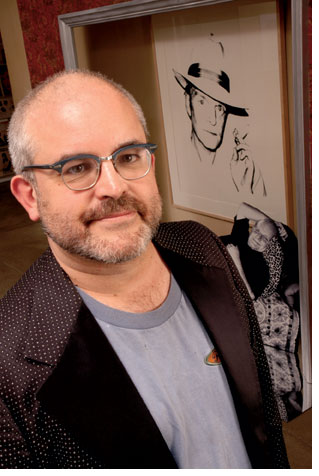Back
 Steve
O’Hearn has a level of creative energy eclipsing
that of most mere mortals. An industrial and environmental
designer, Steve
O’Hearn has a level of creative energy eclipsing
that of most mere mortals. An industrial and environmental
designer,
a set designer, and a public art developer (he just completed
a scale model of the Allegheny Valley as a stainless-steel
relief handrail that extends over 900 feet at the David
L. Lawrence Convention Center), he might be most famous
for his role as
co-founder and artistic director of Squonk Opera, the
definition-defying musical entity that lives to break
performance art boundaries. O’Hearn has received
more than 50 project grants, art commissions, and awards,
both independently and with Squonk Opera co-founder Jackie
Dempsey, and he is halfway through an innovative, 18-month
partnership with The Andy Warhol Museum as its first
Creative Heights Artist in Residence, a position funded
by The Heinz Endowments.
What exactly is an industrial and environmental designer?
It’s sometimes equated with product design…things
we have in our homes. When I was an industrial designer,
I was designing some products and clothing, shoes, and
buttons. As an environmental designer, I created theater
sets, fountains, and interiors.
How did you get into set
design and public art development?
I decided I was very unhappy as an environmental designer.
I was working for a company that developed food courts.
I decided I would do work that
was self-initiated, work I was proud of. It’s a lot
more insecure, but much more exciting.
You have a very diverse background in art, design, music,
and performing. Which is your first love?
I don’t separate art and design. That’s the
quandary with the museum world and the industrial design
world; they think of them as two different paths. Mostly,
I’m a visual person. Theater and music are such big
collaborative efforts. I spend most of my time running
Squonk Opera with Jackie (who creates the music). That
requires 10 people on the road and 30 in production. But
I like working solo a lot—in part because I don’t
do it much. At The Warhol, there are two very different
acts. Most of the work I’m involved in is done with
eight people in a room having meetings, figuring out what’s
next and what’s needed. And then I go home and work
on it by myself. Both parts are enjoyable, and they’re
great in contrast to each other, but I would go crazy without
having time to invent on my own.
How did Squonk Opera come to be?
Jackie and I and one other person started working together
12 years ago and decided we wanted to do shows. I’d
just done some wacky installations and little shows at
some place on the South Side that’s not there anymore
and at Metropol (the former Strip District club) when Jackie
approached me about working together.
When
she approached you, did you have a clear idea of what you’d
be doing?
Not at all. But over the first couple of years we discovered
that it was
a very appropriate mix, essentially mixing a band making
original music with avant-garde visual theater. And that’s,
in essence, what Squonk Opera is, but we didn’t
know it at the time. What we discovered is that together
we
make something really great and that’s why it’s
lasted for 12 years.
What led you to apply for a Creative
Heights grant to work with The Andy Warhol Museum?
I remember asking myself, ‘what Pittsburgh cultural
institutions interest me?’ The Warhol ended up at
the top. So I just gave The Warhol Museum Director Tom
Sokolowski a call. He was very responsive right from the
get-go.
What are your goals/objectives for your residency at The
Warhol?
The project I recently designed, Seeing Double,
was driven by very direct educational needs for the public
visiting
the exhibition. That was kind of limiting in some ways.
What I want to do next is to think more broadly about
what kind of experience it would be coming into a museum.
The
Warhol is already charting a new path where museums have
some of the tone of other large group activities, like
going to a rock concert or
a club. It would be great to have events of some kind that
peer groups—and at The Warhol, there are a couple
of clear groups like youth and gays— could attend
regularly. One of the primary things I’m working
with the staff to do is make the museum an even more vibrant
and contemporary environment.
Back
| Top |